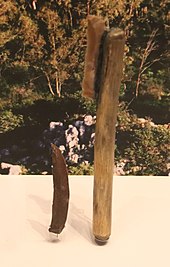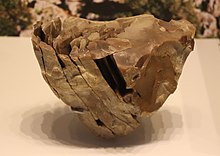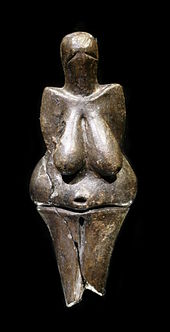Upper Paleolithic
 Löwenmensch, a prehistoric ivory sculpture discovered in Hohlenstein-Stadel, c. 40,000–35,000 years old | |
| Period | Stone Age |
|---|---|
| Dates | 50,000 to 12,000 BP |
| Preceded by | Middle Paleolithic |
| Followed by | Mesolithic |
| Part of a series on |
| Human history and prehistory |
|---|
| ↑ before Homo (Pliocene epoch) |
| ↓ Future (Holocene epoch) |
The Upper Paleolithic (or Upper Palaeolithic) is the third and last subdivision of the
.The Upper Paleolithic has the earliest known evidence of organized
The
Lifestyle and technology
Both , before 50,000 years ago all the stone tools are much alike and unsophisticated.

Firstly among the artefacts of Africa, archeologists found they could differentiate and classify those of less than 50,000 years into many different categories, such as projectile points, engraving tools, knife blades, and drilling and piercing tools. These new stone-tool types have been described as being distinctly differentiated from each other; each tool had a specific purpose. The early modern humans who expanded into Europe, commonly referred to as the
The Neanderthals continued to use Mousterian stone tool technology and possibly Châtelperronian technology. These tools disappeared from the archeological record at around the same time the Neanderthals themselves disappeared from the fossil record, about 40,000 cal BP.[6]

Settlements were often located in narrow valley bottoms, possibly associated with hunting of passing
The changes in human behavior have been attributed to changes in climate, encompassing a number of global
Notational signs

Some notational signs, used next to images of animals, may have appeared as early as the
Changes in climate and geography
The climate of the period in Europe saw dramatic changes, and included the
This period saw cultures such as the Solutrean in France and Spain. Human life may have continued on top of the ice sheet, but we know next to nothing about it, and very little about the human life that preceded the European glaciers. In the early part of the period, up to about 30 kya, the Mousterian Pluvial made northern Africa, including the Sahara, well-watered and with lower temperatures than today; after the end of the Pluvial the Sahara became arid.

The Last Glacial Maximum was followed by the
As the glaciers receded sea levels rose; the
Timeline
50,000–40,000 BP
50,000 BP
- Numerous Aboriginal stone tools were found in gravel sediments in Castlereagh, Sydney, Australia. At first when these results were new they were controversial; more recently dating of the same strata has revised and corroborated these dates.[12][13]
- Start of the Mousterian Pluvial in North Africa.
- Occupants of the Fa-Hien Lena cave, Sri Lanka had developed bow and arrow technology 48,000 BP (though the earliest known bow and arrow technology dates to about 65,000 BP from Sibudu Cave, South Africa[14][15][16][17]).
48,000 BP
The first direct evidence for Neanderthals hunting cave lions. This is based on a cave lion skeleton found in Seigsdorf, Germany which has hunting lesions.[18]
45,000–43,000 BP
- Earliest evidence of modern humans found in Europe, in Southern Italy.[19] These are indirectly dated.[20]
- Earliest mathematical artifact, the notched Eswatini (Swaziland), southern Africa.[21]
- Oldest-known mining in archaeological record, the Ngwenya Mine in Swaziland, at about 43,000 years ago, where humans mined hematite to make the red pigment ochre.[22][23]
- Earliest directly dated figurative cave art of mankind at Leang Bulu' Sipong in Sulawesi, Indonesia.[24]
43,000–41,000 BP
- Microlithic artefacts have been excavated from Kana, West Bengal, India.
- Ornaments and skeletal remains of modern humans, at Ksar Akil in Lebanon. These are directly dated.[20]
- Denisova hominins live in the Altai Mountains(Russia, China, Mongolia, and Kazakhstan).
40,000–30,000 BP
40,000–35,000 BP

- First human inhabitants in Perth, Australia, as evidenced by archaeological findings on the Upper Swan River.[25]
- During this time period, Melbourne, Australia was occupied by hunter-gatherers.[26][27]
- Early cultural centre in the Swabian Alps, oldest depiction of a human being (Venus of Hohle Fels), beginning of the Aurignacian.
- Löwenmensch figure created in Hohlenstein-Stadel, one of the earliest figurative art. It is now in Ulmer Museum, Ulm, Germany.
- The first flutesappear in Germany.
- Notational signs in caves, apparently conveying calendaric meaning about the behaviour of animal species drawn next to them, are the first known (proto-)writing in history .[28][9]
- Most of the giant vertebrates and megafauna in Australia became extinct.
- Fishing of pelagic fish species at Jerimalai shelter, Timor.

Venus of Dolní Věstonice, the oldest surviving ceramic figurine in the world (29,000 – 25,000 BC) - Examples of
- Wall painting with horses, rhinoceroses and aurochs is made at Chauvet Cave, Vallon-Pont-d'Arc, Ardéche gorge, France. Discovered in December 1994.
- Evidence for continued Neanderthal presence in the Iberian Peninsula at 37,000 years ago was published in 2017.[31]
- Archaeological studies support human presence in the Chek Lap Kok area (now Hong Kong International Airport) from 35,000 to 39,000 years ago.[32]
- Taghlar caves in Azerbaijan.
- First evidence of people inhabiting Japan.[33]
35,000 BP
- Kostenki XVII, a layer of the Don River, was occupied by the early upper paleolithic Spitsyn culture.
30,000 BP
- First ground stone tools appear in Japan.[34]
- End of the Mousterian Pluvial in North Africa.
- The area of Sydney was occupied by Aboriginal Australians (specifically, the Eora and Dharug people) during this time period, as evidenced by radiocarbon dating.[35] In an archaeological dig in Parramatta, Western Sydney, it was found that the Aboriginals used charcoal, stone tools and possible ancient campfires.[36]
- First human settlement in Alice Springs, Northern Territory, Australia.[37]
- oceanic islandand for navigating the open ocean.

30,000–20,000 BP
29,000–25,000 BP
- Eruption of the Carpathians.
- Venus of Dolní Věstonice (Czech Republic). It is the oldest known ceramic in the world.
- Venus of Willendorf, Austria, created. It is now at the Natural History Museum, Vienna.
- The Red Lady of Paviland lived around 29,000–26,000 years ago. Recent evidence has come to light that he was a tribal chief.[citation needed]
- Human settlement in Beijing, China dates from about 27,000 to 10,000 years ago.[38]
24,000 BP
- Start of the second Mousterian Pluvial in North Africa.
23,000 BP
- Venus of Petřkovice is created at Petřkovice in Ostrava, Czech Republic. It is now in Archeological Institute, Brno.
22,000 BP
- Last Glacial Maximum: Venus of Brassempouy, Grotte du Pape, Brassempouy, Landes, France, created. It is now at Musée des Antiquités Nationales, Saint-Germain-en-Laye.
21,000 BP
- Artifacts suggests early human activity occurred at some point in Canberra, Australia.[39] Archaeological evidence of settlement in the region includes inhabited rock shelters, rock art, burial places, camps and quarry sites, and stone tools and arrangements.[40]
- End of the second Mousterian Pluvial in North Africa.
20,000–10,000 BP
- Last Glacial Maximum. Mean sea levels are believed to be 110 to 120 metres (360 to 390 ft) lower than present,[41] with the direct implication that many coastal and lower riverine valley archaeological sites of interest are today under water.
18,000 BP
- Spotted Horses, Pech Merle cave, Dordogne, France are painted. Discovered in December, 1994.
- Ibex-headed spear-thrower, from Le Mas-d'Azil, Ariège, France, is made. It is now at Musée de la Préhistoire, Le Mas d'Azil.
- Mammoth-bone village in Mezhyrich, Ukraine is inhabited.
17,000 BP
- Spotted human hands are painted at Pech Merle cave, Dordogne, France. Discovered in December 1994.
- Oldest Dryas stadial.
- Hall of Bulls at Lascaux in France is painted. Discovered in 1940. Closed to the public in 1963.
- Bird-Headed man with bison and Rhinoceros, Lascaux, is painted.
- Lamp with ibex design, from La Mouthe cave, Dordogne, France, is made. It is now at Musée des Antiquités Nationales, Saint-Germain-en-Laye.
- Paintings in Cosquer Cave are made, where the cave mouth is now under water at Cap Margiou, France.
15,000 BP
- Bølling interstadial.
- Bison, Le Tuc d'Audoubert, Ariège, France.
- Paleo-Indians move across North America, then southward through Central America.
- Pregnant woman and deer (?), from Laugerie-Basse, France was made. It is now at Musée des Antiquités Nationales, St.-Germain-en-Laye.
14,000 BP

- Older Dryas stadial, Allerød interstadial.
- Paleo-Indians searched for big game near what is now the Hovenweep National Monument.
- Bison, on the ceiling of a cave at Altamira, Spain, is painted. Discovered in 1879. Accepted as authentic in 1902.[clarification needed]
- Younger Dryas stadial.
- Beginning of the Holocene extinction.
12,000 BP
11,000 BP
- First evidence of human settlement in Argentina.
- The Arlington Springs Man dies on the island of Santa Rosa, off the coast of California, United States.
- Human remains deposited in caves which are now located off the coast of Yucatán, Mexico.[42]
- Creswellian culture settlement on Hengistbury Head, England, dates from around this year.
10,000 BP
- Evidence of a massacre near upper paleolithic warfare.[43]
Cultures

| The Paleolithic |
|---|
| ↑ Pliocene (before Homo) |
| ↓ Mesolithic |
The Upper Paleolithic in the Franco-Cantabrian region:
- The Châtelperronian culture was located around central and south western France, and northern Spain. It appears to be derived from the Mousterian culture, and represents the period of overlap between Neanderthals and Homo sapiens. This culture lasted from approximately 45,000 BP to 40,000 BP.[6]
- The Aurignacian culture was located in Europe and south west Asia, and flourished between 43,000 and 26,000 BP. It may have been contemporary with the Périgordian (a contested grouping of the earlier Châtelperronian and later Gravettian cultures).
- The Gravettian culture was located across Europe. Gravettian sites generally date between 33,000 and 20,000 BP.
- The Solutrean culture was located in eastern France, Spain, and England. Solutrean artifacts have been dated c. 22,000 to 17,000 BP.
- The Magdalenian culture left evidence from Portugal to Poland during the period from 17,000 to 12,000 BP.
- Central and east Europe:
- 33,000 BP, Gravettian culture in southern Ukraine[44]
- 30,000 BP, Szeletian culture
- 22,000 BP, Pavlovian, Aurignacian cultures
- 13,000 BP, Ahrensburg culture (Western Germany, Netherlands, England)
- 12,000 BP, Epigravettian
- North and west Africa, and Sahara:
- 32,000 BP, Aterian culture (Algeria, Libya)
- 12,000 BP, Ibero-Maurusian(a.k.a. Oranian, Ouchtatian), and Sebilian cultures
- 10,000 BP, Capsianculture (Tunisia, Algeria)
- Central, south, and east Africa:
- 50,000 BP, Fauresmith culture
- 30,000 BP, Stillbayan culture
- 12,000 BP, Lupembian culture
- 11,000 BP, Magosian culture (Zambia, Tanzania)
- 9,000 BP, Wiltonian culture
- West Asia (including Middle East):
- 50,000 BP, Jabroudian culture (Levant)
- 40,000 BP, Amoudian culture
- 30,000 BP, Emireh culture
- 20,000 BP, Aurignacian culture
- 12,000 BP, Kebarian, Athlitian cultures
- South, central and northern Asia:
- 30,000 BP, Angara culture
- 11,000 BP, Khandivili culture
- East and southeast Asia:
- 30,000 BP, Sen-Doki culture
- 16,000 BP, Ancient Japan
- 12,000 BP, pre-Jōmon ceramic culture (Japan)
- 10,000 BP, Hoabinhian culture (Northern Vietnam)
- 9,000 BP, Jōmonculture (Japan)
- Oceania:
See also
- Last Glacial Maximum
- Mesolithic
- Neolithic
- Neolithic Europe
- Behavioral modernity
- Cro-Magnon 1
- Aurignacian
- Epigravettian
- Sungir
- Cultural universal
- Quaternary extinction event
- Early human migrations
- Dean R. Snow – A leading archeologist who has conducted extensive Paleolithic research.
References
- Gilman, Antonio (1996). "Explaining the Upper Palaeolithic Revolution". Pp. 220–239 (Chap. 8) in Contemporary Archaeology in Theory: A Reader. Cambridge, MA: Blackwell.
- ^ a b "'Modern' Behavior Began 40,000 Years Ago In Africa", Science Daily, July 1998
- PMID 19581595.
- ^ Gilman, Antonio. 1996. "Explaining the Upper Palaeolithic Revolution". pp. 220–239 (Chap. 8) in Contemporary Archaeology in Theory: A Reader. Cambridge, Massachusetts: Blackwell
- ^ "Klein: Behavioral and Biological Origins of Modern Humans 3 of 3". Access Excellence.
- ^ "Klein: Behavioral and Biological Origins of Modern Humans 1 of 3". Access Excellence.
- ^ S2CID 205239973.
- Middle Pleistocene (Banfield 1961:170; Kurtén 1968:170) and continuing to the present. ... The caribou/wild reindeer is thus an animal that has been a major resource for humans throughout a tremendous geographic area and across a time span of tens of thousands of years." Ernest S. Burch, Jr. "The Caribou/Wild Reindeer as a Human Resource", American Antiquity, Vol. 37, No. 3 (July 1972), pp. 339–368.
- ^ "The Middle to Upper Paleolithic Transition".
- ^ S2CID 255723053.
- PMID 24039825.
- ^ PMID 24039825.
- ISBN 978-1-74223-116-7. Retrieved 11 Nov 2013.
- JSTOR 40387277.
- .
- .
- S2CID 162438490.
- .
- PMID 37828055.
- ^ Wilford, John Noble (2 November 2011). "Fossil Teeth Put Humans in Europe Earlier Than Thought". The New York Times.
- ^ PMID 24039825.
- PMID 22847420.
- ^ Swaziland Natural Trust Commission, "Cultural Resources – Malolotja Archaeology, Lion Cavern," Retrieved August 27, 2007, "Swaziland National Trust Commission – Cultural Resources – Malolotja Archaeology, Lion Cavern". Archived from the original on 2016-03-03. Retrieved 2016-02-05..
- ^ Peace Parks Foundation, "Major Features: Cultural Importance." Republic of South Africa: Author. Retrieved August 27, 2007, [1].
- PMID 33523879.
- ^ Bowdler, Sandra. "Human settlement". In Denoon, D. (ed.). The Cambridge History of the Pacific Islanders. Cambridge, England: Cambridge University Press. pp. 41–50. Cited in Bowdler, Sandra. "The Pleistocene Pacific". University of Western Australia. Archived from the original on 16 February 2008. Retrieved 26 February 2008.
- ISBN 0-9577728-0-7
- Keilor, about 40,000 years ago."
- ^ "Mysterious marks on Ice Age cave art may have been ancient records". Science News. 27 January 2023. Archived from the original on 15 February 2023. Retrieved 15 February 2023.
- ^ "Red dot becomes 'oldest cave art'". BBC News. 15 June 2012. Retrieved 27 November 2022.
- S2CID 7807664.
- PMID 29188235.
- ^ "The Trial Excavation at the Archaeological Site of Wong Tei Tung, Sham Chung, Hong Kong SAR". Hong Kong Archaeological Society. January 2006. Archived from the original on 3 March 2009. Retrieved 21 August 2010.
- ^ "Prehistoric Archaeological Periods in Japan". Charles T. Keally.
- ISBN 0-8248-1853-9
- ^
- Macey, Richard (2007). "Settlers' history rewritten: go back 30,000 years". The Sydney Morning Herald. Retrieved 5 July 2014.
- Blainey, Geoffrey (2004). A Very Short History of the World. Penguin Books. ISBN 978-0-14-300559-9.
- ISBN 978-0-14-300559-9.
- ^ "Arrernte Aboriginal Art and Culture Centre Alice Springs". Archived from the original on 24 May 2011. Retrieved 30 May 2011.
- ^ "The Peking Man World Heritage Site at Zhoukoudian". 2014-11-14.
- ISBN 978-0-9590255-0-7.
- Cosquer cave
- ^ "Divers find traces of ancient Americans". NBC News. 9 September 2004.
- .
"Here we report on a case of inter-group violence towards a group of hunter-gatherers from Nataruk, west of Lake Turkana ... Ten of the twelve articulated skeletons found at Nataruk show evidence of having died violently at the edge of a lagoon, into which some of the bodies fell. The remains ... offer a rare glimpse into the life and death of past foraging people, and evidence that warfare was part of the repertoire of inter-group relations among prehistoric hunter-gatherers."
"Evidence of a prehistoric massacre extends the history of warfare". University of Cambridge. 20 Jan 2016. Retrieved 20 Mar 2017..
For early depiction of interpersonal violence in rock art see:
S2CID 162983574..
- ^ Carpenter, Jennifer (20 June 2011). "Early human fossils unearthed in Ukraine". BBC. Retrieved 21 June 2011.
- ^ Mulvaney, D J and White, Peter, 1987, Australians to 1788, Fairfax, Syme & Weldon, Sydney
- ISBN 0-9577004-2-3. This book describes in some detail the archaeological evidence regarding aboriginal life, culture, food gathering and land management, particularly the period from the flooding of Bass Strait and Port Phillip from about 7–10,000 years ago, up to the European colonisation in the nineteenth century.
- ^ Dousset, Laurent (2005). "Daruk". AusAnthrop Australian Aboriginal tribal database. Archived from the original on April 9, 2011. Retrieved 27 August 2012.
- ^ "Aboriginal people and place". Sydney Barani. 2013. Retrieved 5 July 2014.
- ^ Thorley, Peter (2004). "Rock-art and the archaeological record of Indigenous settlement in Central Australia". Australian Aboriginal Studies (1). Retrieved 18 June 2011.
External links
- The Upper Paleolithic Revolution. Archived 2009-11-13 at the Wayback Machine.
- Picture Gallery of the Paleolithic (reconstructional palaeoethnology) – Libor Balák at the Czech Academy of Sciences, the Institute of Archaeology in Brno, The Center for Paleolithic and Paleoethnological Research.

